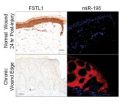(Press-News.org) In addition to its well-known effects on the CNS, alcohol consumption has a significant impact on metabolism. After consumption, the body rapidly begins converting ethanol to acetate, which can serve as an energy source for the brain and other organs. Lihong Jiang and colleagues at Yale University used a brain imaging technique, magnetic resonance spectroscopy, to track acetate uptake and metabolism in the brains of heavy drinkers (consumed at least 8 drinks/week) and light drinkers (consumed less than 2 drinks/week). In this issue of the Journal of Clinical Investigation, they report that heavy drinkers had greater, more rapid acetate uptake and metabolism compared to light drinkers. Because ethanol consumption can cause acute drops in blood glucose levels, acetate has the potential to provide a compensatory energetic reward. Additionally, acetate metabolism produces adenosine, which has a sedating effect similar to alcohol. These findings suggest that the provision of acetate and/or enhancement of adenosine during alcohol detoxification could help alleviate withdrawal symptoms.
###
TITLE:
Increased brain uptake and oxidation of acetate in heavy drinkers
AUTHOR CONTACT:
Lihong Jiang
Yale School of Medicine, New Haven, CT, USA
Phone: 203-785-2953; E-mail: lihong.jiang@yale.edu END
Enhanced brain acetate metabolism may reward heavy drinkers
2013-03-08
ELSE PRESS RELEASES FROM THIS DATE:
JCI early table of contents for March 8, 2013
2013-03-08
Enhanced brain acetate metabolism may reward heavy drinkers
In addition to its well-known effects on the CNS, alcohol consumption has a significant impact on metabolism. After consumption, the body rapidly begins converting ethanol to acetate, which can serve as an energy source for the brain and other organs. Lihong Jiang and colleagues at Yale University used a brain imaging technique, magnetic resonance spectroscopy, to track acetate uptake and metabolism in the brains of heavy drinkers (consumed at least 8 drinks/week) and light drinkers (consumed less than 2 drinks/week). ...
Genetic study of house dust mites demonstrates reversible evolution
2013-03-08
ANN ARBOR—In evolutionary biology, there is a deeply rooted supposition that you can't go home again: Once an organism has evolved specialized traits, it can't return to the lifestyle of its ancestors.
There's even a name for this pervasive idea. Dollo's law states that evolution is unidirectional and irreversible. But this "law" is not universally accepted and is the topic of heated debate among biologists.
Now a research team led by two University of Michigan biologists has used a large-scale genetic study of the lowly house dust mite to uncover an example of reversible ...
New fish species described from the streams of Manyas Lake basin, Turkey
2013-03-08
The newly described species Alburnoides manyasensis, belongs the large carp family Cyprinidae that includes freshwater fishes such as he carps, the minnows, and their relatives. This is the largest fish family, and more notably the largest family of vertebrate animals, with the remarkable numbers of over 2,400 species. Cyprinids are highly important food fish because they make the largest part of biomass in most water types except for fast-flowing rivers.
The genus Alburnoides is widely distributed in Turkey in rivers and streams of basins of the Marmara, Black and ...
Mom's sensitivity helps language development in children with hearing loss
2013-03-08
CORAL GABLES, FL (March 8, 2013) -- University of Miami (UM) Psychologist Alexandra L. Quittner leads one of the largest, most nationally representative studies of the effects of parenting on very young, deaf children who have received cochlear implants. The findings indicate that mothers who are most sensitive in their interactions with their children receiving cochlear implants have kids that develop language faster, almost "catching up" to their hearing peers. The report is published in the Journal of Pediatrics.
"I was surprised that maternal sensitivity had such ...
BRAF inhibitor treatment causes melanoma cells to shift how they produce energy
2013-03-08
A multi-institutional study has revealed that BRAF-positive metastatic malignant melanomas develop resistance to treatment with drugs targeting the BRAF/MEK growth pathway through a major change in metabolism. The findings, which will be published in Cancer Cell and have been released online, suggest a strategy to improve the effectiveness of currently available targeted therapies.
"We were surprised to find that melanoma cells treated with the BRAF inhibitor vemurafenib dramatically change the way they produce energy to stay alive," says David E. Fisher, MD, PhD, chief ...
A*STAR scientists discover 'switch' critical to wound healing
2013-03-08
Patients with diseases such as diabetes suffer from painful wounds that take a long time to heal making them more susceptible to infections that could even lead to amputations. A*STAR's discovery paves the way for therapeutics to improve healing of such chronic wounds, which are a significant burden to patients.
1. Scientists from A*STAR's Institute of Medical Biology (IMB) have identified a molecular "switch" that controls the migration of skin cells necessary for wounds to close and heal. This is especially significant for diabetics and other patients who suffer from ...
Stanford scientists calculate the carbon footprint of grid-scale battery technologies
2013-03-08
Americans take electrical power for granted whenever they flip on a light switch. But the growing use of solar and wind power in the United States makes the on-demand delivery of electricity more challenging.
A key problem is that the U.S. electrical grid has virtually no storage capacity, so grid operators can't stockpile surplus clean energy and deliver it at night, or when the wind isn't blowing.
To provide more flexibility in managing the grid, researchers have begun developing new batteries and other large-scale storage devices. But the fossil fuel required to ...
Home toxic home
2013-03-08
EAST LANSING, Mich. — Most organisms would die in the volcanic sulfur pools of Yellowstone and Mount Etna. Robust simple algae call it home, and their secrets to survival could advance human medicine and bioremediation.
Mike Garavito, Michigan State University professor of biochemistry and molecular biology was part of a research team that revealed how primitive red algae use horizontal gene transfer, in essence stealing useful genes from other organisms to evolve and thrive in harsh environments.
Their study, published in the current issue of Science, shows that the ...
Anti-aging drug breakthrough
2013-03-08
Drugs that combat ageing may be available within five years, following landmark work led by an Australian researcher.
The work, published in the March 8 issue of Science, finally proves that a single anti-ageing enzyme in the body can be targeted, with the potential to prevent age-related diseases and extend lifespans.
The paper shows all of the 117 drugs tested work on the single enzyme through a common mechanism. This means that a whole new class of anti-ageing drugs is now viable, which could ultimately prevent cancer, Alzheimer's disease and type 2 diabetes.
"Ultimately, ...
Virus and genes involved in causation of schizophrenia
2013-03-08
Viruses and genes interact in a way that may increase the risk of developing schizophrenia significantly. This happens already in the developing foetus.
An international team of scientists led by Aarhus University, Denmark, has made this discovery. As the first in the world, they scanned the entire genome of hundreds of sick and healthy people to see if there is an interaction between genes and a very common virus - cytomegalovirus - and to see whether the interaction influences the risk of developing schizophrenia.
And it does.
Women that have been infected by the virus ...



